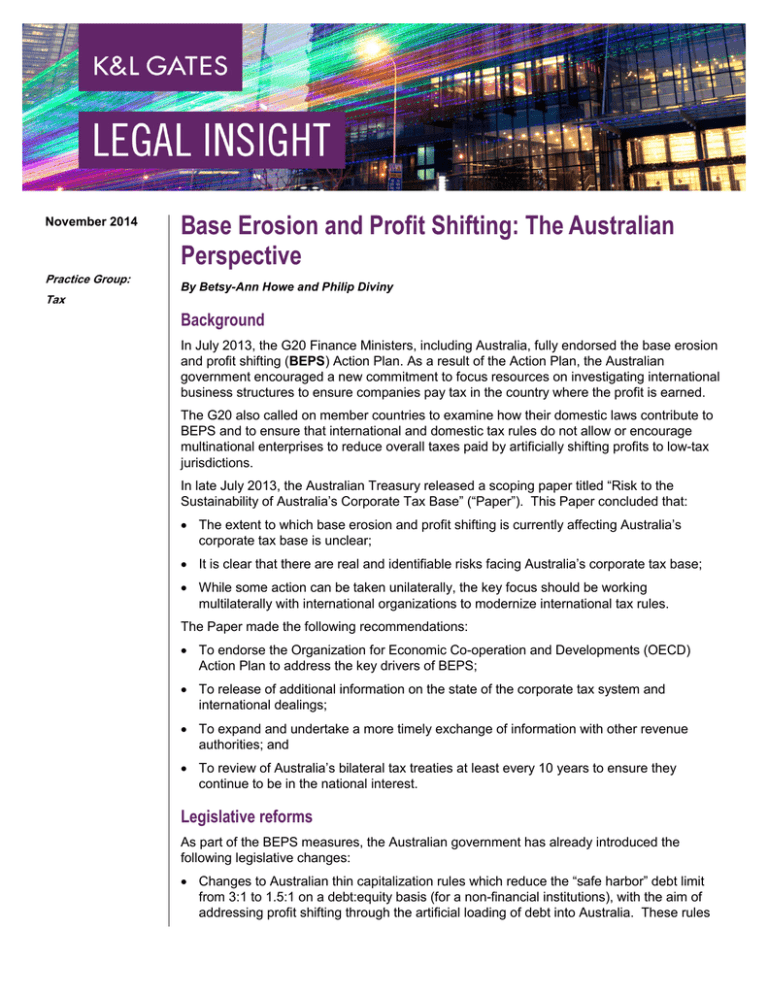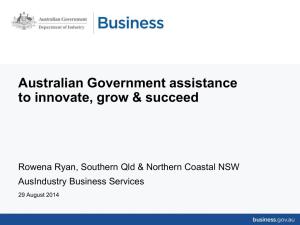
November 2014
Practice Group:
Base Erosion and Profit Shifting: The Australian
Perspective
By Betsy-Ann Howe and Philip Diviny
Tax
Background
In July 2013, the G20 Finance Ministers, including Australia, fully endorsed the base erosion
and profit shifting (BEPS) Action Plan. As a result of the Action Plan, the Australian
government encouraged a new commitment to focus resources on investigating international
business structures to ensure companies pay tax in the country where the profit is earned.
The G20 also called on member countries to examine how their domestic laws contribute to
BEPS and to ensure that international and domestic tax rules do not allow or encourage
multinational enterprises to reduce overall taxes paid by artificially shifting profits to low-tax
jurisdictions.
In late July 2013, the Australian Treasury released a scoping paper titled “Risk to the
Sustainability of Australia’s Corporate Tax Base” (“Paper”). This Paper concluded that:
• The extent to which base erosion and profit shifting is currently affecting Australia’s
corporate tax base is unclear;
• It is clear that there are real and identifiable risks facing Australia’s corporate tax base;
• While some action can be taken unilaterally, the key focus should be working
multilaterally with international organizations to modernize international tax rules.
The Paper made the following recommendations:
• To endorse the Organization for Economic Co-operation and Developments (OECD)
Action Plan to address the key drivers of BEPS;
• To release of additional information on the state of the corporate tax system and
international dealings;
• To expand and undertake a more timely exchange of information with other revenue
authorities; and
• To review of Australia’s bilateral tax treaties at least every 10 years to ensure they
continue to be in the national interest.
Legislative reforms
As part of the BEPS measures, the Australian government has already introduced the
following legislative changes:
• Changes to Australian thin capitalization rules which reduce the “safe harbor” debt limit
from 3:1 to 1.5:1 on a debt:equity basis (for a non-financial institutions), with the aim of
addressing profit shifting through the artificial loading of debt into Australia. These rules
Base Erosion and Profit Shifting: The Australian Perspective
have passed through Parliament and are currently waiting Royal Assent. Once they
receive Royal Assent they will apply to income years commencing on or after July 1,
2014, and will materially impact on the availability of interest and other debt deductions
available in Australia to a multinationals Australian operations.
• New transfer pricing rules which apply from July 1, 2013 and are broader in scope than
the previous rules. The new rules require a detailed consideration of arm’s length pricing
and conditions and also give the Australian Tax Office (ATO) reconstructive powers on
transactions. However, the rules do not extend to rules on the attribution of profits to
permanent establishments, and it is unclear if and when Australia will adopt the OECD
approach in respect of PE profit attribution.
• New measures have been introduced in Australia that are intended to improve the
transparency of Australia’s corporate tax system. Under these rules, the Commissioner
of Taxation is required to publish certain tax information of large corporate taxpayers (on
a named basis), including the total income as reported in the entity’s tax return.
Other Projects Underway
The Australian government continues to be an active participant in the current global debate
on BEPS. At the September 2014 G20 Finance Ministers’ meeting in Cairns Australia, it
reaffirmed its commitment to address the challenges raised by BEPS.
More recently, as a result of further Australian government encouragement, there has been a
further commitment on the part of the ATO to focus resources on investigating international
business structures to ensure companies pay tax in the country where the profit is earned.
Some of the specific measures and projects underway include:
Addressing tax challenges of the digital economy
In an E-Commerce project, the ATO has identified business structures that exacerbated the
BEPS risk, generating income from highly mobile and valuable intellectual property. Five tax
agencies came together to investigate global tax planning of e-commerce multinational
enterprises (MNEs), giving them a better understanding of such companies and enabling
them to examine the MNE’s compliance with existing law.
The ATO’s International Structuring and Profit Shifting program (ISAPS) focuses on
companies that have significant cross-border-related party arrangements or that have
undertaken international restructures. Results from the first year of reviews provide evidence
to support consideration of whether any law reform would be needed.
The ATO is reviewing its advance pricing arrangement and Mutual Agreement Procedure
programs, particularly to have in place early engagement procedures.
Hybrid mismatch arrangements
While Australia does not have specific anti-hybrid mismatch rules, any potential action in this
area will depend on risk levels from hybrid mismatches and taking into consideration work
already underway in relation to existing anti-avoidance measures, such as changes to the
thin capitalization rules.
2
Base Erosion and Profit Shifting: The Australian Perspective
Australia does have rules (such as the debt/equity rules and the Taxation of Financial
Arrangement (TOFA) rules) that can operate to characterize certain financial arrangements
based on their economic substance rather than their legal form. There is potential for a
mismatch in characterization to occur where such financial arrangements are being issued
and held cross-border.
Australia’s Board of Tax (an advisory body to the government on taxation matters) has been
requested to undertake a review of Australia’s debt/equity rules with the view of advising the
government on whether these rules can be improved to address any inconsistencies
between Australia’s tax system and that of other jurisdictions in respect of debt and equity
classifications for tax purposes, with the aim of minimizing arbitrage opportunities. The
Board of Tax is to report to the government by March 2015 on this issue.
Prevention of treaty abuse
Australia has a strong interest in developing a Principal Purpose Test in its bilateral tax
treaties due to the difficulties in applying Pt IVA anti-avoidance measures to complex
offshore arrangements. The objective of having such a test will be to deal with instances of
intended treaty abuse.
Transfer pricing documentation
The ATO is reviewing the impact of the OECD’s recommended country-by-country reporting
documentation on its administrative and compliance products. This documentation will
require a master file of standardized information for all members of the multinational group
and then a local file containing material transactions referable to the local taxpayer. It is also
considering the inclusion of a materiality threshold, i.e. to have a minimum global turnover
before being obliged to report.
Broader transparency issues
Other global transparency measures such as the automatic exchange of information and
implementation of the Common Reporting Standard, are supported by the ATO’s compliance
approaches, e.g., the International Dealings Schedule, reportable tax positions, reporting of
large company financials, and Project DO IT.
Compliance Activities of the ATO
The ATO’s 2013-14 Compliance Program has a heavy focus on BEPS, with profit shifting
being identified as a significant tax compliance risk for medium to large businesses.
The ATO has established a new compliance project team called 'International Structuring
and Profit Shifting' which will review profit shifting risks and undertake risk review and audits
in this area, with the following focus areas:
• migration of intangibles (IP) offshore
• creation of offshore hubs
• debt push down/excessive interest arrangement in Australia
• tax arbitrage via hybrid entities/instruments
3
Base Erosion and Profit Shifting: The Australian Perspective
• base erosion via related-party leveraging
• treaty abuse
• transfer pricing outcomes that are inconsistent with arm's length outcomes including so
called "tax effective supply chains".
Conclusion
Global businesses with a presence in Australia need to be aware of the issues associated
with BEPS and should be undertaking a risk review of their cross-border activities. The ATO
is conducting risk reviews in this area and currently transfer pricing reviews and audits are on
the increase in Australia.
Going forward taxpayers will need to monitor legislative changes in this area and new
approaches being adopted by the ATO in compliance activities and documentation
requirements.
Authors:
Betsy-Ann Howe
betsy-ann.howe@klgates.com
+61.2.9513.2365
Philip Diviny
philip.diviny@klgates.com
+61.3.9640.4221
Anchorage Austin Beijing Berlin Boston Brisbane Brussels Charleston Charlotte Chicago Dallas Doha Dubai Fort Worth Frankfurt
Harrisburg Hong Kong Houston London Los Angeles Melbourne Miami Milan Moscow Newark New York Orange County Palo Alto Paris
Perth Pittsburgh Portland Raleigh Research Triangle Park San Francisco São Paulo Seattle Seoul Shanghai Singapore Spokane
Sydney Taipei Tokyo Warsaw Washington, D.C. Wilmington
K&L Gates comprises more than 2,000 lawyers globally who practice in fully integrated offices located on five
continents. The firm represents leading multinational corporations, growth and middle-market companies, capital
markets participants and entrepreneurs in every major industry group as well as public sector entities, educational
institutions, philanthropic organizations and individuals. For more information about K&L Gates or its locations,
practices and registrations, visit www.klgates.com.
This publication is for informational purposes and does not contain or convey legal advice. The information herein should not be used or relied upon in
regard to any particular facts or circumstances without first consulting a lawyer.
© 2014 K&L Gates LLP. All Rights Reserved.
4







